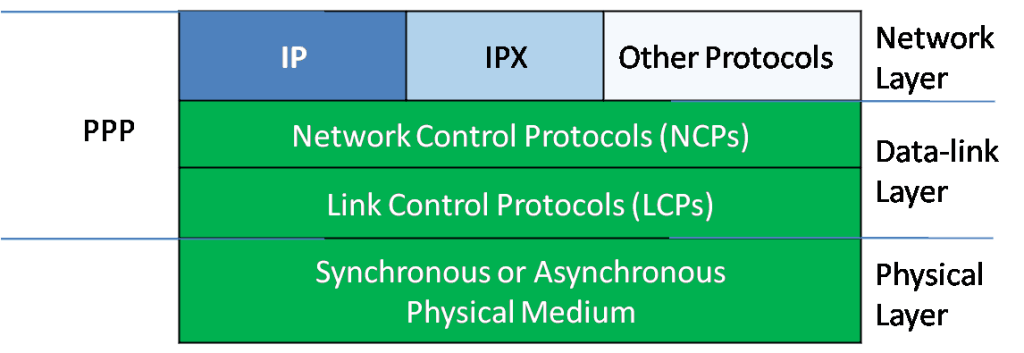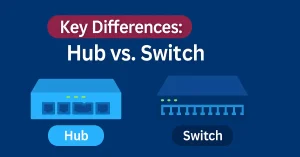A layered architecture is a logical model that aids communication between interconnecting layers. We can map the Point-to-Point Protocol (PPP) layer model with the Open System Interconnection (OSI) model. Both Point-to-Point Protocol (PPP) and OSI models share the same physical layer although the Point-to-Point Protocol (PPP) distributes the functions of Link Control Protocol (LCP) and Network Control Protocol (NCP) differently.
We can configure various interfaces at the physical layer, including Asynchronous serial, Synchronous serial, HSSI, and ISDN. Point-to-Point Protocol (PPP) operates across any DTE/DCE interface including RS-232, RS-422, RS423 or V.35. The figure below illustrates the layered model of the Point-to-Point Protocol (PPP). LCP and NCP primarily work in the data-link layer and network layer. The LCP sets up the Point-to-Point Protocol (PPP) connection, including connection parameters. It is also responsible for connection termination. The NCPs handle higher-layer protocol configurations.

Link Control Protocol (LCP)
The Link Control Protocol (LCP) establishes, configures, and tests data-link connections. PPP sends and receive LCP packet before establishing communications over a point-to-point link. The LCP packet may be accepted or rejected based on a linked peer, packet size and other configurations. The LCP packet checks the identity of its linked peer, sets the packet size limits, and also check sfor common configuration errors. Once the LCP packet accepts the link, traffic can be forwarded on the network. If the LCP packet found the link is not working correctly, it terminates the link. The LCP packet has three different types.
- Link configuration packets
- Link termination packets
- Link maintenance packets
The LCP provides automatic configuration of the interfaces at each end. The LCP also negotiates and sets up control options on the WAN data link, which are handled by the NCPs. When the link is established, PPP also uses the LCP to agree automatically on encapsulation formats such as authentication, compression, and error detection.
Network Control Protocol (NCP)
Network Control Protocol (NCP) was an early protocol implemented by ARPANET. The ARPANET is the world’s first operational packet-switching network that later evolved into what became the Internet. Network Control Protocol (NCP) is the part of Point − to − Point Protocol (PPP). It is a data link layer protocol used for transmitting multi-protocol data between two point-to-point devices. PPP uses a separate NCP for each network layer protocol. For example, IPv6 uses the IPv6 Control Protocol (IPv6CP) and IPv4 uses IPv4 Control Protocol (IPCP). Each NCP manages the particular needs required by its relevant network-layer protocols. Different components of NCP encapsulate and negotiate options for multiple network-layer protocols.
NCP allowed access and use to remote devices at remote locations and to transmit files between devices and computers. NCP is part of the protocol stack and enables application services such as email and file transfer. TCP/IP was replaced by NCP in the 1980s.
Point-to-Point Protocol (PPP) Frame
PPP is a byte-oriented protocol. A PPP frame contains six fields. Each PPP frame is composed of one or more bytes. The fields of a PPP frame are illustrated in the figure below:-

Flag – Flag field marks the beginning and the end of the Point-to-Point Protocol (PPP) frame. It flags the standard HDLC field containing 8 bits. The bits pattern of the flag field is 01111110.
Address – It is a bit field that contains the binary sequence. In case of broadcast, the sequence is set to 11111111, PPP does not assign individual station addresses.
Control – This is a one-byte long field with the binary sequence 00000011. The value 00000011 shows that the frame does not contain any sequence numbers. It provides a connectionless link service for a point-to-point link. So, for PPP, the Address field is set to 0xFF, the broadcast address. If both Point-to-Point Protocol (PPP) peers agree to do address and control field compression during the LCP negotiation, the Address field is not included.
Protocol – The protocol field is either one bit or two bits long and identifies the protocol encapsulated in the information field of the frame. If the field is 2-byte, the field specifies the protocol of the PPP payload. If both PPP peers agree for the compression of the protocol field during LCP negotiation, the Protocol field is reduced to one byte for the protocol identification. The up-to-date values of the Protocol field are specified in the most recent Assigned Numbers Request For Comments (RFC).
Data/Payload – Data field is variable in length. It specifies the kind of packet in the data field, i.e., what is being carried in it. The data field can contain user data or other information. If the length is not negotiated using LCP during line setup, a default length of 1500 bytes is used.
Frame Check Sequence (FCS) – FSC stands for Frame Check Sequence. It is a 2-byte or 4-byte frame check sequence for error detection. The 2-byte frame is standard; however, LCPs can negotiate modifications to the standard PPP frame structure.
FAQs
What is Point-to-Point Protocol (PPP)?
PPP is a data link layer protocol used to establish a direct connection between two networking nodes.
What are the main components of PPP?
The main components of PPP include encapsulation, link control protocol (LCP), and network control protocols (NCPs).
How does PPP ensure secure communication?
PPP uses authentication protocols like Password Authentication Protocol (PAP) and Challenge Handshake Authentication Protocol (CHAP) to ensure secure communication.
What is the role of the Link Control Protocol (LCP) in PPP?
LCP is responsible for establishing, configuring, testing, maintaining, and terminating links for transmission.
Can PPP support multiple network layer protocols?
Yes, PPP can support multiple network layer protocols by using different Network Control Protocols (NCPs) for each protocol.
I hope this covers everything! If there’s anything more you need, feel free to let me know.




